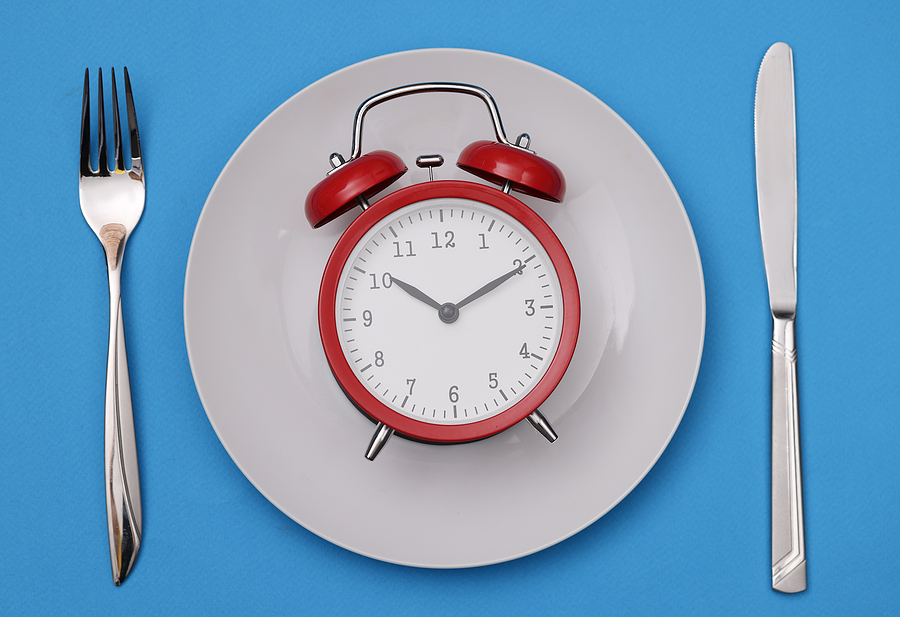A recent study on younger women produced noteworthy results, and it has implications for we not-so-young women.
It was an Australian-Norwegian collaboration carried out in Melbourne and looked at the effect of combining two recent trends in diet and exercise — time restricted eating and high intensity interval training.
Here’s a quick recap on each one.
Time-restricted eating (TRE)
TRE refers to eating over a period of 8 to 12 hours, and not eating for the other 12 to 16 hours of the day.
It’s different from intermittent fasting (IF), although the two are often referred to as the same thing. IF involves restricting calories. The 5:2 diet is an example of IF because we cut calories on two days.
In TRE there’s no requirement to eat less, just to fit what we eat into a certain timeframe.
It probably means we will eat a bit less though, because having a cut-off time often curbs after-dinner nibbling or that extra glass of wine.
Research on TRE suggests that while people can lose weight doing this, other health benefits, such as lower blood pressure and blood glucose levels, seem to occur independent of weight loss.
Noone’s sure yet exactly how TRE works, but human metabolism seems primed for using energy in the earlier part of the day, and if we match our food intake to this and eat earlier, we’re less likely to go to bed with high blood sugar.
Research suggests that finishing eating by 7.00pm is beneficial. And remember that type 2 diabetes isn’t the only health problem linked to high blood sugar. It’s a big factor in chronic disease generally.
Having said that, participants in the Melbourne study doing TRE were asked to confine their eating to a 10-hour window of their choosing.
TRE is attracting attention because it seems doable for a lot of people. While diets are hard to sustain, TRE doesn’t ask us to eat less, just to eat within a particular window of time.
High Intensity Interval Training (HIIT)
Some of us would be more familiar with HIIT which involves short bouts of higher intensity aerobic exercise separated by low intensity breaks.
Like TRE it’s been shown to reduce weight and belly fat, but exercise impacts almost every organ and tissue in the body, including our brain, heart, bones, liver, pancreas and, of course, muscles.
Combining the two
The research was carried out over seven weeks, and although this fell during Covid-19 lockdown, the results were promising.
One hundred and thirty-one overweight but healthy women (average age about 36) were divided into four groups — one did TRE, which as I’ve mentioned, was with a 10-hour window of their choice; one did three supervised 35-minute HIIT sessions a week; a third group did both; and the last group, the control group, did neither.
When the results were in, the TRE group had reduced their nighttime blood sugar levels, the HIIT group was fitter, and both groups had lost body fat (1.6 kgs for TRE, 1.5 kgs for HIIT).
But the combined group, in addition to improving fitness and blood sugar, had lost around double the amount of fat (3.1 kgs). In all cases this fat loss was especially around the belly.
While we need many more trials with different types of people to build up this picture, if the combined approach made this much difference with healthy young women in seven weeks, it has a lot of potential for older people whose health may be more compromised.
Implications for older people
There are two obvious ones.
First, it works to top and tail our eating day rather than grazing continuously, especially at night.
The women in the Melbourne study, who were likely managing work and families, fulfilled on the 10-hour window by having a late breakfast and finishing eating by 8.00pm. Although research supports eating by 7.00pm, they still produced strong results.
So there’s flexibility in this. If 10 hours seems unsustainable, do 12. Even a modest narrowing of the daily window is beneficial.
Of course, if you prefer the 5:2 format or any other structure that curtails free-range eating, stick with that.
Second, exercise consistently.
While HIIT was used in this study, research on healthy ageing shows that it doesn’t matter whether exercise is moderate or intense, it just needs to be regular.
Is there a better time of day to exercise? Although you might occasionally come across an article that says there is, thus far there’s no evidence for that. As the Nike ad says, just do it.
The more we know about what works, the more we’re able to choose what suits us. The key is finding little shifts we can build into our lifestyle. Over time, little shifts make a big difference.
Photo Source: Bigstock

